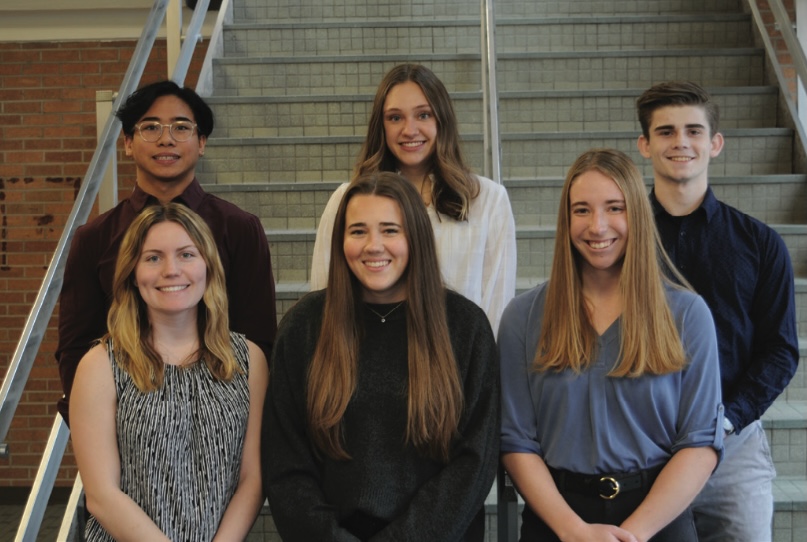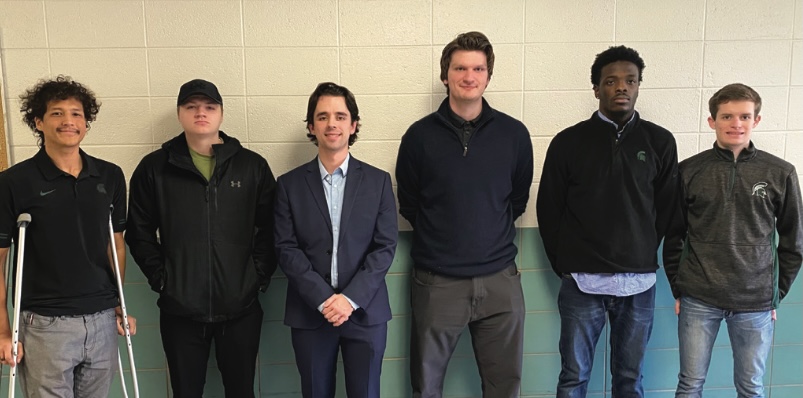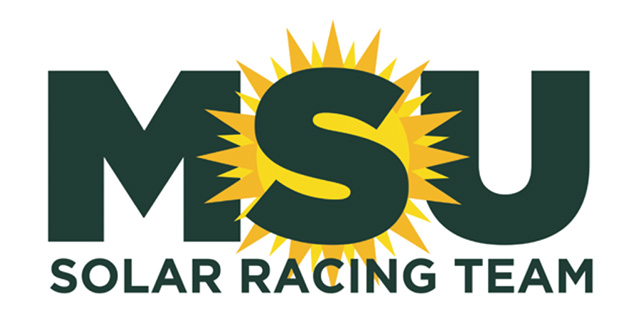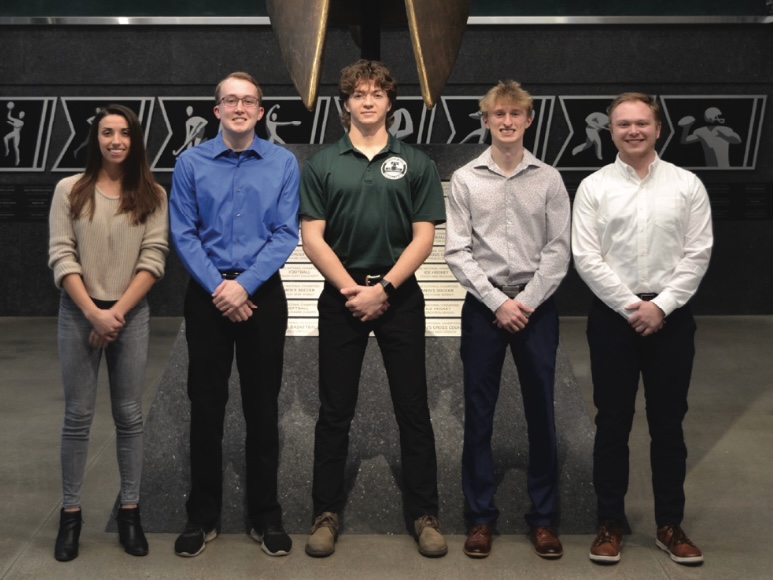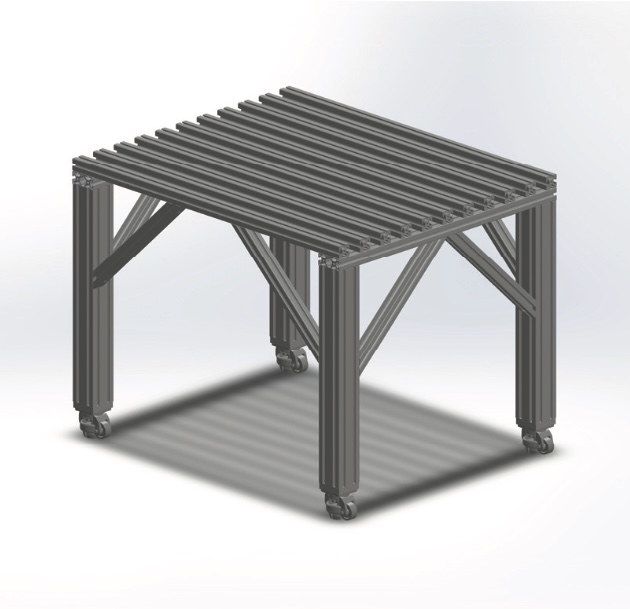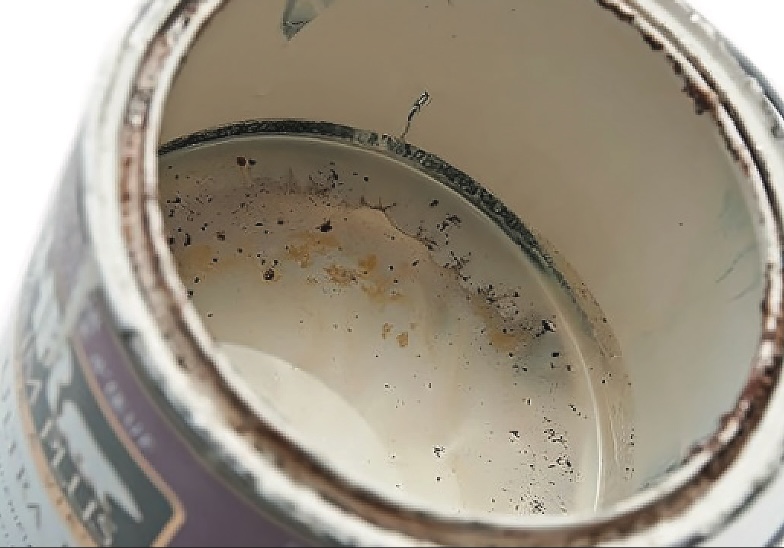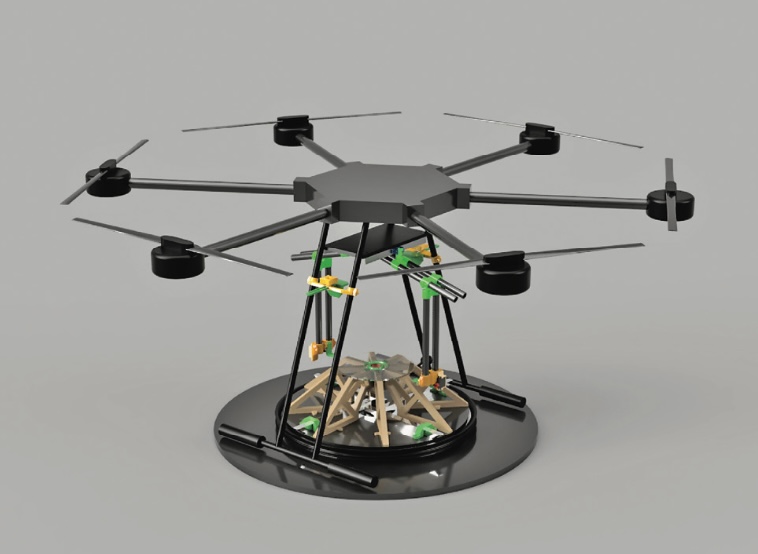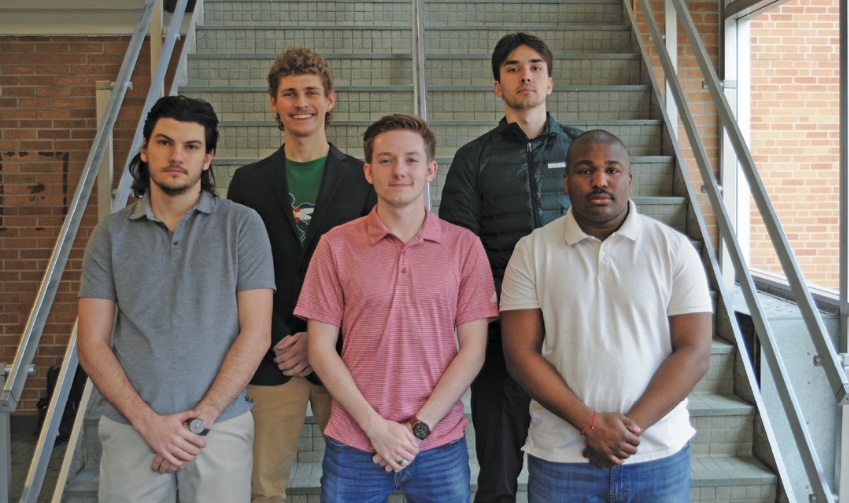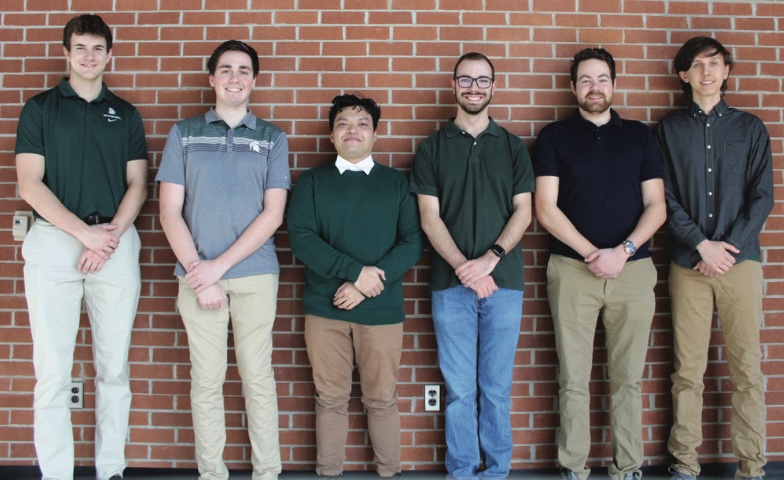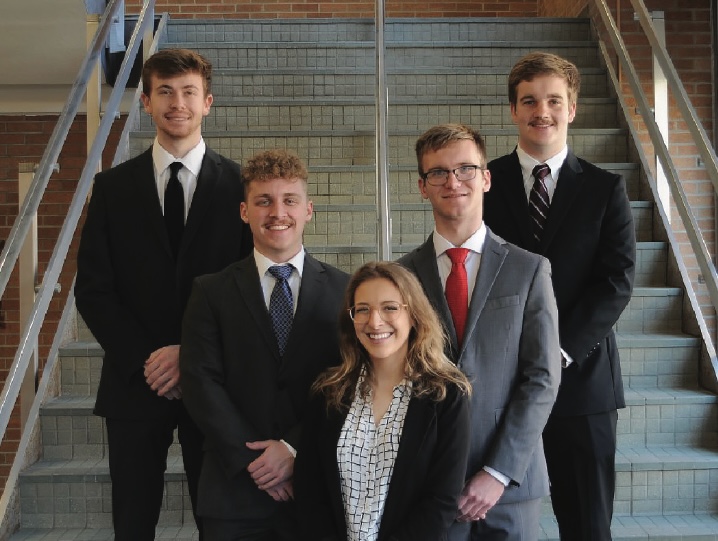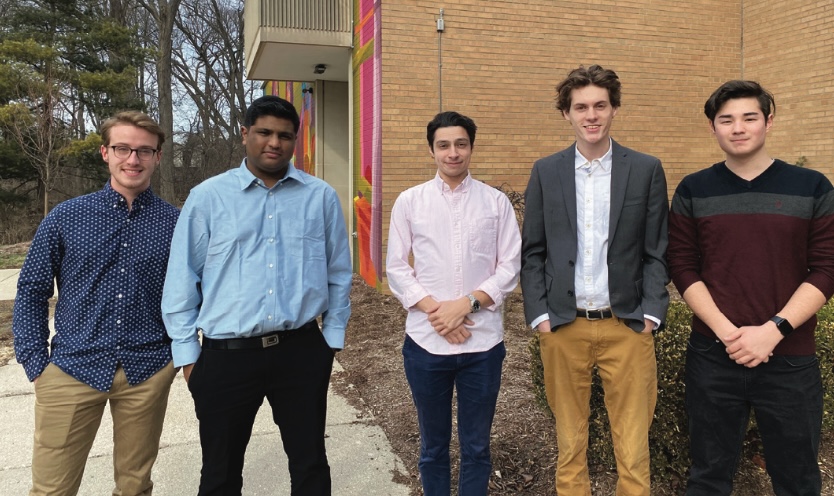MSU College of Engineering: Combined Easel and Board Storage Cart Design 1
MSU College of Engineering: Combined Easel and Board Storage Cart Design 2
MSU College of Engineering: Easel Storage Cart Development and Production Build
MSU Adaptive Sports & Recreation Club: Increased Roller Sled Mobility: Phase IV
MSU Adaptive Sports & Recreation Club: Inclusive Sports Wheelchair: Phase VIII
MSU Adaptive Sports & Recreation Club: Sled Hockey Transfer Platform: Phase VI
MSU Adaptive Sports & Recreation Club: 3-Wheel Drive System for Scooter: Phase 2
Michigan AgrAbility: Tractor Manlift Finite Element Analysis
MSU Solar Racing Team: Electric Vehicle Powertrain Development
PPG Industries/MSU Formula Racing Team: Carbon Fiber Reinforced Polymer Wheels
Michigan Chestnut Industry: Chestnut Harvester Design
MSU Department of Mechanical Engineering: HPVC Build Table Design and Fabrication
MSU Department of Theatre: Paint Can Shaker
Battleship New Jersey Museum & Memorial: USS Monitor Mooring System
MSU AIDED Team: Delivery Drone to Bus Charging Latch
Our Next Energy: Trailer Hitch Force via Strain Gage
Cleveland-Cliffs, Inc.: Cart Design for Moving Production Steel Rolls 1
Cleveland-Cliffs, Inc.: Cart Design for Moving Production Steel Rolls 2
Hitachi Astemo Americas, Inc.: Performance Characterization of a TMD for Vehicles
Alro Steel: Plasma Burning Facility Process Improvements
Asahi Kasei Plastics North America: Strand Management Application Process Improvements
Wheels on Rails LLC: Rail Bike Design 1
Wheels on Rails LLC: Rail Bike Design 2
MSU Department of Mechanical Engineering: Design and Analysis of a Four-Stroke Hydrogen Engine
Cobra AERO: Design of Two-Stroke Cycle Power Dense Engine
UV-C Safe, Inc.: Germicidal Transaction Portal
UV-C Safe, Inc.: Home Application
UV-C Safe, Inc.: Germicidal Card Reader Cleaner
MSU Department of Mechanical Engineering: Crisis Window Replacement
General Motors: Sound Design for Electric Vehicles
Consumers Energy: Turboexpander Feasibility Study
MSU College of Engineering: Combined Easel and Board Storage Cart Design 1
Michigan State University was founded in 1855, conferred its first engineering undergraduate degrees in 1888, and has been a leader in research and teaching since that time. In preparing students for a future in the engineering field, numerous presentations and events are held. There are currently 11 undergraduate programs and 9 graduate programs, each of which participate in Design Day or the graduate research symposium. These are just two examples of when students and faculty display posters highlighting their projects to others at the university. The school currently owns 300 easels, foam boards, and binder clips used to display work across campus.
As of the beginning of the semester, the easels were stored in repurposed bakery carts with the trays removed, while the boards and clips were stored in cardboard boxes in laundry hampers. Both the bakery rack and cardboard boxes were not sturdy, nor convenient. The loading and unloading of easels was challenging and time-consuming, and the cardboard boxes that the posterboards were stored in were flimsy, leading to damage when not handled extremely carefully. Also, for shorter people, it was difficult to lift them out. Previously, it required multiple people to push both carts, which was inefficient when setting up and taking down. There were two existing improved carts provided by the sponsor, yet they only held easels. The combination of carts, boards, and clips on one vessel with a small storage footprint was essential for the college. Our goal was to create a cart that held 50 easels, 50 boards, and 250 binder clips. It was important to maximize sturdiness while minimizing weight since it had to be easy to move through doors and hallways, as well as outside when transporting it to different campus buildings. Lastly, loading and unloading the easels and posterboards had to be easy for one person to do.
Michigan State University
Team Members (left to right)
Ryan-Cristofer Curamen
Shelby Township, Michigan
Jaclyn Duff
Shelby Township, Michigan
Paxton Angliss
Flushing, Michigan
Emily Peterson
Farmington, Michigan
Beth Caldwell
Brighton, Michigan
Jessica Ray
Clarkston, Michigan
MSU College of Engineering
Project Sponsors
Sandy Christlieb
East Lansing, Michigan
Katy Colbry
East Lansing, Michigan
ME Faculty Advisor
Dr. Tony Gao
MSU College of Engineering: Combined Easel and Board Storage Cart Design 2
The Michigan State College of Engineering is one of the oldest and largest colleges on the MSU campus and strives to develop young aspiring engineers and prepare them for future careers. One of the ways it accomplishes this is by hosting yearly events that showcase Spartan talent and provide opportunities for students to create connections, attend seminars, and display their work. With the wide array of today’s successful news and highlights, it is obvious that the College of Engineering members are pioneering leaders, embracing Michigan State University’s tradition of advancing and transforming lives through innovative teaching and research.
Posterboards, along with the easels to hold them, are used at various events across the MSU campus. In the past the easels and posterboards were transported on a cart that was difficult to use and dangerous. Our goal was to design an ergonomic cart that is sturdy, allows for easier loading/unloading, and is safer than the current storage system. The new storage cart makes it easier to keep track of the easels in a safe and organized way. The foam board storage keeps the boards dry and protects against wear so they will not have to be replaced as often. Overall, the new cart is easy to manufacture and meets all the required needs specified by the College of Engineering.
Michigan State University
Team Members (left to right)
Valentin Borjas
Detroit, Michigan
Derek Hanson
Linden, Michigan
Austin Shepp
Flushing, Michigan
Greg Koenigsknecht
Lansing, Michigan
David Olawale
Ann Arbor, Michigan
Kyle Roland
Clarkston, Michigan
MSU College of Engineering
Project Sponsors
Sandy Christlieb
East Lansing, Michigan
Katy Colbry
East Lansing, Michigan
ME Faculty Advisor
Dr. Tony Gao
MSU College of Engineering: Easel Storage Cart Development and Production Build
The MSU College of Engineering was established in 1885, with the goal of providing an unprecedented learning environment to prepare students for their future careers in Engineering. The College of Engineering offers ten undergraduate programs and eleven graduate disciplines. The faculty and staff of the college transform lives and advance engineering knowledge through teaching and research.
The MSU College of Engineering hosts various events throughout the year, using easels to display event posters. The easels are stored on carts that carry up to 50 easels per cart. In Fall 2022, two easel storage carts were designed and built to replace the original cart design. It was imperative that the carts could be transported easily, the easels could be loaded and unloaded easily, and the number of easels on each cart could be easily counted. The goal of this project was to determine which of the two new cart designs would be best suited for long-term use and production manufacturing. To make that determination, testing of the carts and optimization of the costs was completed. Based on the selected design, three additional carts were built.
Michigan State University
Team Members (left to right)
Brittany Bush
Fowlerville, Michigan
Tommy McGowan
Troy, Michigan
Ben Finkbeiner
Birmingham, Michigan
Sean Lickfold
Novi, Michigan
Olivia Lage
Macomb, Michigan
MSU College of Engineering
Project Sponsors
Sandy Christlieb
East Lansing, Michigan
Katy Colbry
East Lansing, Michigan
ME Faculty Advisor
Dr. Ricardo Mejia-Alvarez
MSU Adaptive Sports & Recreation Club: Increased Roller Sled Mobility: Phase IV
Adaptive sports is growing at MSU and enables more and more people to participate in sports. From basketball to tennis to hockey, MSU Adaptive Sports is helping make more sports available to those with disabilities. The focus of this project is on hockey. Para ice hockey uses sleds to move around the ice so that users with decreased leg mobility are able to play hockey. The players use the ends of their sticks to push off of the ice and navigate around the rink.
Since ice time is very difficult to schedule at MSU, an existing hockey sled has been modified to work on hard playing surfaces like those in Dem Hall and Jenison Fieldhouse. The main goal of this project was to improve the mobility of the sled so that it acts as if it is on ice, while being used on a hard and uneven playing surface. We incorporated and enhanced the existing designs of the sled while maintaining the control and safety.
Michigan State University
Team Members (left to right)
Henry Horak
New Lenox, Illinois
Noah Moyer
Grosse Pointe, Michigan
Ryan Bartlett
Howell, Michigan
Joey Rheaume
Grosse Pointe, Michigan
Faith Call
Las Vegas, Nevada
Dylan Huck
Fenton, Michigan
MSU Adaptive Sports & Recreation Club
Project Sponsors
Piotr Pasik
East Lansing, Michigan
ME Faculty Advisor
Dr. Mohsen Zayernouri
MSU Adaptive Sports & Recreation Club: Inclusive Sports Wheelchair: Phase VIII
The MSU Adaptive Sports & Recreation Club is an organization in East Lansing, Michigan that has been offering free opportunities for people with physical disabilities to engage in a range of adaptive sports and games since 2014. It is a leading program that has created a safe and inclusive environment for people with disabilities and able-bodied volunteers to experience sports from an inclusive perspective. It provides a supportive and welcoming community that is continually innovating to create a place in sports for all people. The club promotes physical health, social behavior, and psychological wellness through adaptive sports and has established an integrated community through a variety of sports: sled hockey, wheelchair hockey, wheelchair rugby, and adapted track & field. The goal of the MSU Adaptive Sports & Recreation Club is to provide a self-determination approach focusing on athlete autonomy, competence, and relatability, leading to success both in sports and in other domains to ultimately improve their quality of life.
This project focused on the eighth phase of the inclusive sports wheelchair designed for an ambulatory individual with asymmetrical functionality who is also an active participant in the MSU Adaptive Sports & Recreation Club. In the seven previous iterations the steering, braking, and propulsion systems were modified to increase the effectiveness and robustness of the wheelchair. The ultimate goal of this eighth phase of the project was to further improve the overall performance of the wheelchair by building on the work of previous teams and incorporating the feedback of the intended user very closely. Some components the team strived to modify in this iteration included the stability and reliability of the chair. These improvements will hopefully allow the intended user to participate in their favorite sport, tennis, and other adaptive sports with maximum comfort and ease.
Michigan State University
Team Members (left to right)
Sarthak Gupta
Ludhiana, India
Jeffrey Li
Troy, Michigan
Srikeerthi Kothapally
Farmington Hills, Michigan
Alejandro Castillo
New York City, New York
Anjali Patel
Shelby Township, Michigan
MSU Adaptive Sports & Recreation Club
Project Sponsors
Piotr Pasik
East Lansing, Michigan
ME Faculty Advisor
Dr. Ahmed Naguib
MSU Adaptive Sports & Recreation Club: Sled Hockey Transfer Platform: Phase VI
MSU’s Adaptive Sports & Recreation Club is an organization that promotes health and physical activity for those with physical disabilities. The goal of this group is to provide opportunities for all by working against societal limitations that prevent access to sports. Allowing for easier access to sports gives players the opportunity to participate in independent, healthy, and social activities. The program adopts a self-determination approach that focuses on athlete autonomy, competence, and relatedness as key facilitators in the process of acquiring self-efficacy in the area of sports and physical activity. MSU Adaptive Sports & Recreation Club continuously creates applied academic initiatives for MSU students, which are intended to increase understanding of disability via engineering designs.
Our team focused on the sled hockey docking mechanism. The design involved using the existing sled hockey transfer platform from Phase V and modifying the docking mechanism to accommodate the needs of individuals with physical disabilities. The design is to enhance the users’ independence while using the transfer platform and docking mechanism. The changes revolved around safety, ease-of-use, and accessibility.
Michigan State University
Team Members (left to right, top to bottom)
Justin Miller
Northville, Michigan
Jack Beison
Kalamazoo, Michigan
Dylan Gumbinger
Rochester, Michigan
Frank Rhoades
Warren, Michigan
Arianna Finn
Northville, Michigan
John Klein
Allen Park, Michigan
MSU Adaptive Sports & Recreation Club
Project Sponsors
Piotr Pasik
East Lansing, Michigan
ME Faculty Advisor
Dr. Seungik Baek
MSU Adaptive Sports & Recreation Club: 3-Wheel Drive System for Scooter: Phase 2
MSU Adaptive Sports & Recreation club provides opportunities for athletes with physical disabilities to participate in sports. The club provides a variety of sports such as wheelchair hockey, wheelchair basketball, wheelchair rugby, and other events for student participants. Through sports, the Adaptive Sports & Recreation Club’s goal is to help improve the physical health of the athletes and create a socially acceptable space for those participants. The Adaptive Sports and Recreation club strives to provide a variety of sports equipment that people of all different backgrounds can use.
In Phase 2 of the project, the main goal was to create a three-wheel drive system on the mobility scooter. By implementing a three-wheel drive system, the mobility scooter would be able to operate in inclement weather and provide more autonomy for physically disabled individuals. Phase 2 continued the progression of Phase 1, where a motor was installed on the front wheel. By connecting the original two-wheel drive system in the rear to the system installed prior, the scooter will have power to all three wheels. With some tuning to provide correct torque to each system, the goal will be achieved.
Michigan State University
Team Members (left to right)
Jyotiraditya Chavan
East Lansing, Michigan
Eui June Shim
Novi, Michigan
Ryan Pawlowski
Lowell, Michigan
Brady O’Shea
Rochester Hills, Michigan
Jacob Rupprecht
Oakland Township, Michigan
Dawu Liu
East Lansing, Michigan
MSU Adaptive Sports & Recreation Club
Project Sponsors
Piotr Pasik
East Lansing, Michigan
ME Faculty Advisor
Dr. Guoming Zhu
Michigan AgrAbility: Tractor Manlift Finite Element Analysis
Michigan AgrAbility provides critical assistance to enable people in the agricultural industry with an injury, illness, or disability to continue working. With Michigan’s farmer population reaching an average age of 60, this continues to be a growing issue for farmers, especially in Michigan. Farmers with mobility impairments due to spinal cord injuries, amputation, stroke, or other conditions cannot climb the steps and ladders to tall farming machinery. Michigan AgrAbility helps farmers find ways to continue doing what they love by researching and developing useful farming tools, equipment, and methods to improve farmers’ ability to work on their farms. They work closely with a network of private funding organizations, including Michigan Rehabilitation Services, to provide these services.
The goal of this project was to apply finite element analysis on the manlift design that is currently used by farmers in order to propose improvements to its overall design. Some issues with the current design include the fact that it is overdesigned and weighs more than the farmers would like. This project is to address these issues without jeopardizing the structural integrity or safety of the manlift. In order to accomplish this, the main focus of the analysis was to identify all potential weak spots in the original manlift design. Our group worked to eliminate these weak spots by changing the structure and material of the manlift, taking into account various conditions the manlift might experience on the farm. With our finalized project, Michigan AgrAbility will be able to use our improved manlift design in farms across the state to assist farmers with mobility impairments. Making its overall structure stronger will help reduce any potential injuries resulting from continuous usage of the manlift.
Michigan State University
Team Members (left to right, top to bottom)
Nicholas Lauinger
Spring Lake, Michigan
Kevin Upcott
Southfield, Michigan
Wade Varney
Portage, Michigan
Connor Anderson
Troy, Michigan
Alexandra Iorga
Northville, Michigan
Jacob Huskin
Noblesville, Indiana
Michigan AgrAbility
Project Sponsors
Ned Stoller
Grand Rapids, Michigan
ME Faculty Advisor
Dr. Norbert Mueller
MSU Solar Racing Team: Electric Vehicle Powertrain Development
The Michigan State University Solar Racing Team is a student- led organization that competitively designs and races solar- powered vehicles. Since 2000 the team has competed in two different events, the Formula Sun Grand Prix (FSGP) and the American Solar Challenge (ASC). FSGP takes place on a racetrack where teams must complete over 600 miles throughout the course of three days. ASC typically spans across four states and over 2,000 miles. While the location varies from year to year, teams compete in as many miles as possible while trying to optimize their speed and efficiency. The MSU Solar Racing Team last competed in 2022 with a multi-occupant vehicle, Aurora, that had been in development since 2016. The team is planning to return with a new single-occupant car, named Cynisca, in 2024.
Throughout Aurora’s design cycle, the team has been learning and looking for opportunities to improve their vehicle design. Currently Aurora, as well as most solar powered vehicles that compete in these two races, utilizes a hub motor. This is an electric motor that mounts directly to the wheel rim and propels the vehicle forward. While these motors are designed specifically for solar car competitions with very high efficiency, they are limited in torque and speed output. Since these are made to order and only produced by two companies, hub motors typically cost anywhere from $8,000 to $20,000. The objective of this capstone project was to explore the applicability of off-the-shelf DC motors that would utilize a gearbox to drive the car. The motor efficiency is lower than the hub motors and the system efficiency of the vehicle was increased due to the current-voltage characteristics of the new motor. Our team explored various electric motors, their output capabilities, designed a gearbox to tune the speed and torque produced, and manufactured the MSU Solar Team’s first gearbox prototype.
Michigan State University
Team Members (left to right)
Austin Tait
Caseville, Michigan
Gus Tsalas
Highland Park, Illinois
Andrew Flight
Schaumburg, Illinois
Valentina Vargas
Clarkston, Michigan
Matthew Price
Livonia, Michigan
Jake Rutkowski
Normal, Illinois
MSU Solar Racing Team
Project Sponsors
Woongkul Lee
East Lansing, Michigan
Adam Peckens
East Lansing, Michigan
ME Faculty Advisor
Dr. André Bénard
PPG Industries/MSU Formula Racing Team: Carbon Fiber Reinforced Polymer Wheels
PPG Industries is a global supplier of paints, coatings, and specialty materials, with over 135 years of experience in the industry. The company operates in over 70 countries and serves a diverse range of industries, including automotive, aerospace, industrial, and consumer goods. PPG is known for its innovation, quality, and commitment to sustainability, investing heavily in research and development to stay ahead of the competition. With its eco-friendly practices and environmentally friendly products, PPG is a leading example of a company that is both successful and socially responsible.
For the past 34 years, Michigan State University has taken part in Formula SAE (FSAE), a collegiate competition that challenges student- led teams to design, build, test, and race a small, open-wheel racecar against universities from all around the world. Over the past year, the Michigan State Formula SAE Team evaluated areas in which the vehicle could be improved. This project is to aid their performance gains and decrease simulated vehicle lap time by replacing the previously used stock OZ Racing wheels with optimized carbon reinforced wheels. Our team designed and manufactured a 7075-aluminum wheel spoke and multi-piece carbon fiber reinforced polymer barrel which are bolted together at six points and then mounted to stock wheel hubs on the vehicle’s suspension system. To determine if the fabricated wheel would decrease simulated lap time, the spoke-barrel assembly was tested to determine weight, lateral stiffness, and moment of inertia. These parameters were input into a Lap Time Simulation and compared the vehicle’s performance with the optimized wheel system to its performance with the OZ Racing wheel parameters. With this design, the MSU Formula Racing Team plans on producing a complete set of four wheels to be used on the vehicle in future competitions.
Michigan State University
Team Members (left to right)
Olivia Reyes
Ann Arbor, Michigan
Garrett Colasinski
Canton, Michigan
Calum Walton
Birmingham, Michigan
Nicholas Coubard
Armada, Michigan
Noah Goldman
Denver, Colorado
PPG Industries/MSU Formula Racing Team
Project Sponsors
Erik Stitt
Pittsburgh, Pennsylvania
ME Faculty Advisor
Dr. Gary Cloud
Michigan Chestnut Industry: Chestnut Harvester Design
The chestnut industry in Michigan is vast and expanding. Currently, Michigan is the top state for chestnut production. Chestnuts are a cultivated agroforestry type crop gaining popularity due to the generally low input production needs and excellent nutritional benefits, resulting in an eco-friendly and sustainable food source. In order for chestnuts to properly mature, they must first fully mature on the tree and fall out of their large spiny burs and onto the ground where they are then ready to be harvested. Currently small farms use a u-pick or handheld picking system for the chestnuts; and the large commercial farms use larger, powered machines, which tend to pick up everything. These machines have a secondary process for sorting the chestnuts from anything else collected from the ground.
The objective of the designed system is to acquire chestnuts from the ground and transfer them onboard an unmanned ground vehicle (UGV) for transportation to the collection site. The design can be attached to the UGV via the adjustable mounting system that enables universal use. The design uses electricity efficiently and eliminates unnecessary movements. This will provide time, cost, and environmental benefits. The UGV is capable of aligning itself with an accuracy of ± 10mm of the desired chestnut’s centroid. Once the UGV is aligned, it will signal subsystems to transfer the targeted chestnut into our designed lifting mechanism. A big challenge was to design something that would get the chestnuts off the ground while also minimizing the chances of obstacles getting caught in the mix. These undesired obstacles include leaves, sticks, burs, and feces. The design is also able to adapt to chestnuts that are more difficult to extract from the ground due to varying grass lengths. Most importantly, the chestnut has biological variability, meaning the designed mechanism also adapts to chestnuts of various sizes and shapes.
Michigan State University
Team Members (left to right)
Nick Dodge
Walled Lake, Michigan
Nolan Houghteling
Pinckney, Michigan
Ciara Regan-Moore
Warren, Michigan
Showgo Yoshida
Saint Claire Shores, Michigan
Rachel Paul
Canton, Michigan
Joe Watza
Ann Arbor, Michigan
Michigan Chestnut Industry
Project Sponsors
Dan Guyer
East Lansing, Michigan
ME Faculty Advisor
Dr. Ranjan Mukherjee
MSU Department of Mechanical Engineering: HPVC Build Table Design and Fabrication
The MSU Human Powered Vehicle Competition (HPVC) team is an organization made up of engineering students that have the objective of designing and manufacturing a three-wheeled vehicle, similar to a bicycle. This vehicle is used in competitions and other events where it can display its performance capabilities. Michigan State University’s HPVC team asked for assistance in designing and fabricating a build table for their vehicle.
The purpose of this project was to build a table that could be used to efficiently fabricate and build a human-powered (three- wheeled) vehicle. This table was to be similar to a bedplate in both use and design, while being tailored specifically to the needs of the HVPC team. T-slots and holes were put in place to hold fixtures that would keep pieces of the bike in place as they were being welded or otherwise assembled. Specifications were given on the allowed deformation limit of the table and all fixtures during the build process. The table also had to be built in such a way that it could be moved without the need for heavy equipment. The team did a full 3D design of this bedplate and FEA verification before manufacturing the physical table itself. Existing materials and parts from 80/20 were utilized as much as possible to streamline the manufacturing process.
Ultimately this project will help the HPVC team as they begin to weld and assemble their vehicle, making the fabrication process of the vehicle easier and more efficient.
Michigan State University
Team Members (left to right)
Edmond Hashem
Ann Arbor, Michigan
Peter Olszewski
Howell, Michigan
Brett Earnest
Lake Orion, Michigan
Khush Patel
Canton, Michigan
Cole Lutkenhoff
Canton, Michigan
MSU Department of Mechanical Engineering
Project Sponsors
Geoffrey Recktenwald
East Lansing, Michigan
William Resh
East Lansing, Michigan
ME Faculty Advisor
Dr. Sara Roccabianca
MSU Department of Theatre: Paint Can Shaker
The Department of Theatre at Michigan State University “challenges the traditional, in order to create something new, unique and fresh.” Each year, many shows and plays are created and performed in front of audiences wishing to receive a one-of-a-kind experience. To make this possible, the MSU Department of Theatre and the MSU Scene Shop work together to create large, detailed set pieces to bring theatre productions alive. The Department of Theatre boasts the most advanced stage technology available to students, which allows designers “the opportunity to defy conventional design.” With massive projects and a busy schedule, the Department of Theatre needs fresh paint that is readily available. Working in partnership with the MSU Department of Theatre and the MSU Scene Shop, the problem of old, separated paint used for the construction of set pieces was solved by finding an effective “paint shaker” design to restore the old paint into usable paint.
Key elements addressed in this project were creating a system that would be strong enough to handle the size and weight of the paint cans, a design that would last a long period of time after multiple uses and one that would operate quietly. In addition, considerations for the safety of the operator, as well as those who would be working around the machine, were made at all stages of the design process. The main concern with paint is the separation of the oils as they sit for long periods of time, and how to effectively re-combine them. With a goal to reduce the manual labor needed to mix the separated paint, we designed a machine that mixes the paint quickly with the press of a button. Our process used oscillations to mix all layers of the separated paint and provide the right consistency for immediate use. A DC motor and a linkage system, which can be switched on and off by a control panel, supplied the desired motion on the paint. To combat vibrations and repeated use, our design is both resilient and robust.
Michigan State University
Team Members (left to right)
Jacob Keller
Rochester, Michigan
David LeVasseur
Dearborn, Michigan
Jonathan Elias
Grand Haven, Michigan
Patrick Mullaly
Brighton, Michigan
Nathan Kramer
Harrison Township, Michigan
Logan Wells
Livonia, Michigan
MSU Department of Theatre
Project Sponsors
Levi Galloway
East Lansing, Michigan
DJ Selmeyer
East Lansing, Michigan
ME Faculty Advisor
Dr. Indrek Wichman
Battleship New Jersey Museum & Memorial: USS Monitor Mooring System
The Battleship New Jersey Museum & Memorial is a non-profit organization that maintains and operates the former warship Battleship New Jersey (BB-62) as a museum in Camden, New Jersey across the Delaware River from Philadelphia, Pennsylvania where the US Navy was founded on October 26, 1775. This floating U.S. Navy museum showcases the nation’s military history from World War II to Korea, Vietnam, and active duty during the 1980s. The Battleship New Jersey Museum and Memorial’s mission is to honor the legacy of the USS New Jersey and those who served on her by restoring, preserving, and exhibiting the ship’s continuing history. They strive to inspire and educate future generations by showcasing the ship’s role in our country’s naval history.
The Battleship New Jersey Museum and Memorial is the host for the national celebrations of the 250th anniversary of the founding of the nation in Philadelphia in 2026. As part of the USA250 celebrations, and for years to come, the Homecoming 250 project is planning to construct a floating replica of the USS Monitor that will be moored alongside the USS New Jersey. To ensure the safe and cost-effective mooring of the USS Monitor, the project will require the design of a mooring system that fits the existing pier structure used by the Battleship. This will involve in-depth mathematical analysis of the current pier structure and mooring systems based on various climate conditions.
Michigan State University
Team Members (left to right)
James Tanay
Okemos, Michigan
Augusto Cucala
Valencia, Spain
Parker Hatherley
Brighton, Michigan
Artik Chowdhury
Chennai, India
Ricardo Paz Weber
Madrid, Spain
Battleship New Jersey Museum & Memorial
Project Sponsors
Alaina Noland
Camden, New Jersey
ME Faculty Advisor
Dr. Giles Brereton
MSU AIDED Team: Delivery Drone to Bus Charging Latch
Aerial Intra-city Delivery Electric Drones (AIDED) is an undergraduate research group that is funded through a grant from NASA’s University Student Research Challenge. AIDED aims to increase the range of generic multirotor package delivery drones with a safe, quiet, and affordable solution. In placing a drone latch on top of public transportation, the vehicle’s range increases from around a mile to as far as the transit network’s footprint spans. Using a proprietary routing and optimization software, drones can be directed from a hub to land on a bus, begin charging from it, and take off at a stop near the delivery destination. Having UAVs bring packages across town has become a contentious topic for the public. The AIDED solution reduces noise and flight risk by being on top of a bus in crowded areas rather than in the air, spending, on average, 90% of the distance on the transit vehicle. The research team is made up of 12 mechanical, electrical, computer science, and data science engineering students.
Around a year ago, a prototype of a latching solution was produced by senior mechanical and electrical engineers on the team. After hours of test landing and charging circuit design the idea was validated using a smaller, less expensive drone. Now this capstone team has been tasked with scaling up that latching solution to fit AIDED’s 8-foot diameter and 20-pound payload capable drone, Hermes. The drone-bus latch features high quality manufacturing methods and materials like carbon fiber and SLS 3D printing. In practice, an infrared beacon at the center of the cone structure beckons the drone to land. Upon a successful connection between the drone and latch’s charging circuit, four bars eject from the latch over a ring attached to the drone. The forces transmitted through this structure from the bus’s acceleration has been simulated to ensure the drone stays secure.
Michigan State University
Team Members (left to right)
Mitchell Essenmacher
Oxford, Michigan
Nicholas Michaels
Farmington Hills, Michigan
Mitchell Semeyn
Milan, Michigan
Ross Davis
Williamston, Michgian
Eric Douglas
Detroit, Michigan
MSU AIDED Team
Project Sponsors
Gavin Gardner
East Lansing, Michigan
Woongkul Lee
East Lansing, Michigan
ME Faculty Advisor
Dr. Norbert Mueller
Our Next Energy: Trailer Hitch Force via Strain Gage
Our Next Energy (ONE) is a Michigan-born energy storage company focused on battery technologies that will accelerate the adoption of electric vehicles and expand energy storage solutions. The company’s vision is to make electric vehicles a viable alternative for everyday use by utilizing cleaner energy sources for sustainability. ONE’s mission is to improve and optimize batteries used in electric vehicles, providing more efficient power consumption that increases performance.
The goal of this project was to develop a force measurement system that could accurately measure the tractive load produced by a trailer, while canceling out all other forces such as bending and torsion. By attaching strain gauges in a certain orientation on our trailer prototype, we were able to achieve our goal as well as demonstrate an accurate force reading. With these data, a closed-loop control system can be fed with the measured force value, controlling an electric vehicle powertrain on the trailer that will make up for energy lost while towing. This project will create a better powertrain management system, thus reducing the cost and resources needed to manufacture the battery. At the same time, with less resources used, it aligns with ONE’s vision of creating a more sustainable energy usage in the electric vehicle industry.
Michigan State University
Team Members (left to right)
Evan Petersen
Canton, Michigan
Nicholas Sarver
Canton, Michigan
Najmi Rahim
Kuala Kangsar, Malaysia
Christian Giggy
Holt, Michigan
Connor Witham
Grand Blanc, Michigan
Zachary Lang
Webberville, Michigan
Our Next Energy (ONE)
Project Sponsors
Chad Krause
Novi, Michigan
Lee Sargent
Novi, Michigan
ME Faculty Advisor
Dr. Xinran (Sharon) Xiao
Cleveland-Cliffs, Inc.: Cart Design for Moving Production Steel Rolls 1
Founded in 1847 and now with 56 operating facilities, Cleveland-Cliffs, Inc. is the largest flat-rolled steel company in North America and is the leading supplier of automotive-grade steel. As a fully integrated plant, they are a self-sufficient mill that takes mined raw materials and scrap to produce all steel products. Cleveland-Cliffs, Inc. has committed to the ongoing sustainability goals in the U.S. and plans to improve water conservation and reduce carbon emissions by 25% by 2030. At the facility in Burns Harbor, Indiana, most everything sold are steel coils. These coils weigh from 50,000 to 80,000 pounds, and approximately 100 coils a day are moved to shipping, while the facility produces 500 coils.
Currently, these coils are moved one by one with a tractor, which is a very slow and inefficient process. The focus of this project was to design a cart that could carry between 4-5 steel coils at once to increase productivity. The cart had to be compatible with the tractor that has been used previously to move the coils, as well as the cranes inside of the facility, so they can be loaded onto the cart efficiently. Additionally, the cart had to support a static load of a weight upwards of 200 tons. The shafts of the cart also had to undergo fatigue analysis to ensure the cart was safe for maneuvering the facility. The design was created using CAD software Siemens NX, and Finite Element Analysis (FEA) was performed using Ansys.
Michigan State University
Team Members (left to right)
Noah Shepard
Midland, Michigan
Sohan Gupta
Calcutta, India
Zoe Quinn
Holland, Michigan
Gus Scheier
East Jordan, Michigan
David Smith
Mohnton, Pennsylvania
Cleveland-Cliffs, Inc.
Project Sponsor
Lauren Hart
Burns Harbor, Indiana
ME Faculty Advisor
Dr. Xinran (Sharon) Xiao
Cleveland-Cliffs, Inc.: Cart Design for Moving Production Steel Rolls 2
Cleveland-Cliffs is the largest flat-rolled steel supplier in North America. Their Burns Harbor facility, located in Northwest Indiana, is Cleveland Cliffs’ second largest U.S. facility. Burns Harbor is a fully integrated steel mill, smelting raw iron ore pellets and casting them into slabs of steel. The plant can produce nearly 5 million net tons of raw steel annually, with their primary product being flat- rolled steel coils. Each steel coil produced at Cleveland-Cliffs weighs in the range of 50 to 80 thousand pounds. Due to their immense size, the coils are currently moved one-by-one into their shipping halls by a heavy-duty tractor. With approximately 100 coils moved per day, this process flow has proved extremely inefficient, creating a shipment delay risk. With such a high demand for these coils in the automotive, construction, and numerous other industries, Burns Harbor is in need of a solution to improve coil transportation within their plant.
Our team’s task was to design a steel coil cart capable of transporting up to five coils at once between the production and shipping buildings at the Burns Harbor facility. Although manufacturing cost, cart functionality, and crane accessibility were key factors in the design process, operator safety remained the forefront of our design. Through the implementation of our steel coil cart, the total time spent in coil transportation between buildings will be cut by approximately 80% at the Burns Harbor Facility. Using materials available in-house and a compatible trailing mechanism, the steel coil cart design would be an innovative solution for the company to improve the logistics and efficiency in product transportation.
Michigan State University
Team Members (left to right)
Andrew Culver
Clarkston, Michigan
Minh Nguyen
Westland, Michigan
Jon Droste
DeWitt, Michigan
Kyle Hellems
DeWitt, Michigan
Joe Nelson
South Haven, Michigan
Cleveland-Cliffs, Inc.
Project Sponsor
Lauren Hart
Burns Harbor, Indiana
ME Faculty Advisor
Dr. Seungik Baek
Hitachi Astemo Americas, Inc.: Performance Characterization of a TMD for Vehicles
With the global trend of electrification in passenger vehicles comes improvements to be made to these automobiles as well. One such example currently being developed by Hitachi Astemo is the use of tuned mass dampers within a vehicle’s suspension to provide a smoother ride for the driver and passengers as well as improved handling capabilities. The use of a tuned mass damper as a part of a vehicle’s suspension is by no means a new idea. It was first used in 1949 by French car manufacturer Citroën in their economy car—the 2CV. It was never of interest to other car manufacturers until 2005 when another French automaker, Renault, incorporated a tuned mass damper into their team’s Formula 1 racecar—the Renault R26. This innovation would prove successful at cornering and gave the team a points lead ahead of their competitors until the regulatory body of Formula 1, the FIA, banned the use of tuned mass dampers in 2006.
Tuned mass dampers (TMDs) are used in many applications such as the reduction of lateral vibrations in tall buildings and communication towers, as well as the reduction in vertical vibrations in automobile suspensions. Their purpose is to reduce the vibrations that are in the system or affecting the system from the outside. The way a TMD can reduce the vibration of an existing system is by introducing a new mass that will oscillate out of phase with the same natural frequency as the system, resulting in deconstructive interference between the two oscillatory waves. In this project, a tuned mass damper will be developed and optimized for HITACHI’s electric vehicles applications in the future.
Michigan State University
Team Members (left to right)
Kevin Roche
Buffalo, New York
David Kwok
Hong Kong, China
Faizan Malik
Lahore, Pakistan
Zaid Almodhi
Ahsa, Saudi Arabia
Al Aiyash
Hamtramck, Michigan
Lucas Russell
Richland, Michigan
Hitachi Astemo
Americas, Inc.
Project Sponsor
Shivanand Sankaran
Farmington Hills, Michigan
ME Faculty Advisor
Dr. Guoming Zhu
Alro Steel: Plasma Burning Facility Process Improvements
Beginning in 1948, Alro Steel has transformed from a small garage in Jackson, Michigan to one of the largest distributors of metals, industrial supplies, and plastics. With 75 locations in 15 states, Alro Steel processes and distributes metals, plastics, and industrial supplies with next day delivery to over 50,000 customers in North America. Alro Steel offers a wide variety of processing capabilities to complement their metal and plastic products. For metals, they offer aluminum plate sawing, flame cutting, grinding, plasma cutting, plate laser cutting, etc. While there are numerous ways to process the raw material, each material is stored based on factors such as: length, thickness, grade, or even whether or not it’s magnetic. As with any industrial metal processing, transport to and from the cutting machine can pose a safety risk, as well as some level of inefficiency. Specifically with the plasma cutter, Alro Steel wanted to know if there was a more safe and efficient way to store and transport the materials destined for the plasma cutting table.
Our team was tasked with developing possible solutions for the storage and transport of materials to and from the plasma cutting table, with worker safety being the top priority. We focused our attention to the unloading processes after the steel plate has been cut. After the plasma cutting has been completed, every steel plate must go to a separate area for an employee who then manually stamps out and collects each piece that has been cut and tabbed into that specific plate. We researched, formulated, and tested a new offloading system to increase the efficiency inside of the Alro Steel facility located in Lansing, Michigan. To compare our results with Alro Steel’s current practices, we also determined the efficiency of the existing offloading processes for all the metal plates destined for the plasma cutting table.
Asahi Kasei Plastics North America: Strand Management Application Process Improvements
Asahi Kasei Plastics North America, Inc. (APNA) is a leading manufacturer of innovative, high performance, engineered polymers and chemically coupled polypropylene resins in North America. With 12 pounds of product in just about every vehicle across the US, APNA’s production lines require well engineered and managed manufacturing processes. APNA is deeply committed to contributing to the development of society and to anticipating in the emergence of new needs.
The task of this project was to make an improvement to the strand management during one of APNA’s manufacturing processes. The design focused on strand placement and alignment as it enters the machinery to improve pellet quality and mitigate damage to expensive equipment. The design also works to remove excess water from previous manufacturing processes, preventing dripping, and improving safety on site. Finally, the design takes into account the abrasiveness of the material itself, allowing for minimal replacement and maintenance costs over time. The team hopes that, in addition to the current project, this design can be scaled and applied to lines across all of APNA’s manufacturing.
Michigan State University
Team Members (left to right, top to bottom)
Edward Kim
Seoul, South Korea
Mark Zum Mallen
Sugar Land, Texas
Shane Beers
Lyons, Michigan
Andrew Reddy
Northville, Michigan
Ryleigh Turner
Dearborn, Michigan
Parker Grover
Ann Arbor, Michigan
Asahi Kasei Plastics North America
Project Sponsors
Nicole Graves
Fowlerville, Michigan
Roy Travis
Fowlerville, Michigan
Holly Trpik
Fowlerville, Michigan
ME Faculty Advisor
Dr. Thomas Pence
Wheels on Rails LLC: Rail Bike Design 1
Wheels on Rails LLC is the first rail-biking excursion company in the state of Michigan. The company allows customers to ride on specially designed railroad bikes that coast down an inactive railroad track near Traverse City, Michigan. Macie Hefron, the owner of the start-up business, reached out to Michigan State University College of Engineering to help her create a railroad bike design of her own. The grand opening for the company is later this spring, when Macie will begin railroad bike tours.
The team was tasked with designing a custom railbike that is cost-effective to build and has several unique features. Some of these features include handicap accessibility, adjustable seats, bounce pads to prevent major damage upon collision, and a removable protective rain shield that will enable business to continue no matter the weather. Along with the design, the team conducted finite element analysis (FEA) to make sure the railbike design was safe. Also, the team provided Wheels on Rails LLC with a detailed cost analysis so the bikes would stay under a requested amount that was set by Wheels on Rails LLC. Finally, shop drawings were also made so that the bike can easily be manufactured by any build shop and not just our design team.
Michigan State University
Team Members (left to right)
Jack Girling
Macomb, Michigan
Jack Konitsney
Rochester, Michigan
Joe Kouchoukos
Naperville, Illinois
Matt Phelan
Byron Center, Michigan
Jack Salisbury
Macomb, Michigan
Wheels on Rails LLC
Project Sponsors
Gary Cola (Flash Steelworks)
Washington Twp, Michigan
Macie Hefron (Wheels on Rails LLC)
Traverse City, Michigan
ME Faculty Advisor
Dr. Thomas Pence
Wheels on Rails LLC: Rail Bike Design 2
Wheels on Rails LLC is the first company in the state of Michigan that allows rail bike riding tours on railroad tracks. They provide a new form of entertainment to the heart of Michigan that currently can’t be experienced nearby. They provide accessible entertainment for people from a broad range of ages and physical mobility constraints. During this first season of operation, Wheels on Rails LLC is renting rail bikes at a high cost. Designing and creating their own rail bikes will save the company money, and improving the current designs will increase customer satisfaction.
Our team was tasked with designing a cost-efficient, improved rail bike and to aid Wheels on Rails LLC in the process of manufacturing the physical prototype. High strength steel tubing is provided to the company by Flash Steelworks, so a frame was designed with this material. In addition to designing the frame, improving upon current rail bike designs involved emphasizing a few key features. These features included increased accessibility to varying individuals’ heights and mobility, storage of users’ personal belongings, and weather coverage, which increased safety. All of these factors needed to be included while still maintaining a low final cost. The final design created also needed to be easily repeated so that multiple, identical bikes could be produced. Increasing accessibility included adjustable seats that enable people of varying heights to be able to comfortably reach the pedals and contribute to the movement of the bike. It also involved swivel seating to allow people with limited mobility easier access in and out of the seats. Increasing storage involved adding baskets for personal belongings and water bottle storage. A cover for the rail bike was designed as well to provide weather coverage, and it can be installed and removed depending upon the weather at the time of the riding tour. Lastly, front and rear bumpers were added to the bike design to allow for increased safety during a potential bike collision.
Michigan State University
Team Members (left to right, top to bottom)
Matthew Lipscomb
Howell, Michigan
David Knapp
Midland, Michigan
Hailey Kelley
Rochester, Michigan
Nathan Jansen
Beulah, Michigan
Thomas Burgess
Lake Orion, Michigan
Wheels on Rails LLC
Project Sponsors
Gary Cola (Flash Steelworks)
Washington Twp, Michigan
Macie Hefron (Wheels on Rails LLC)
Traverse City, Michigan
Tim Potter (MSU Bikes Service Center)
East Lansing, Michigan
ME Faculty Advisor
Dr. Zhaojian Li
MSU Department of Mechanical Engineering: Design and Analysis of a Four-Stroke Hydrogen Engine
Afaculty member from the MSU Department of Mechanical Engineering developed a patented approach to active Turbulent Jet Ignition (TJI) configured in a discrete unit cartridge, which was then licensed to Jetfire Power, LLC for commercialization. TJI systems have been known to provide very high-efficiency engine operation. With Jetfire’s innovative pre-chamber air control, the system is able to robustly ignite very lean or highly dilute stoichiometric mixtures under high compression. The technology, termed a Jetfire® system, is applicable to both liquid and gaseous fuels, including gaseous hydrogen. Its key advantage over other TJI systems is its use of exhaust gas recirculation to dilute the main chamber charge, which provides both ignition advantages as well as knock resistance. This patented pre-chamber air control allows Jetfire to surpass both passive and active competing forms of TJI.
Our team focused on the design, construction, and performance analysis of a hydrogen-powered 4-stroke engine by modifying an engine that used a Jetfire system. We examined both the short- and long-term effects of hydrogen combustion on an engine and selected appropriate spark plugs and injectors that delivered the performance requirements needed. Further, to determine an optimal fuel flow rate given said performance requirements, an engine simulation using GT Suite was created that modelled torque and power output as well as engine efficiency for various fuel-air mixtures. The final, physical prototype served as an illustration of Jetfire’s ultimate mission of improving engine efficiency while removing carbon from the combustion process.
Michigan State University
Team Members (left to right, top to bottom)
Kai Thin
Subang Jaya, Malaysia
Nathan Phelps
Brooklyn, Michigan
Haosen Sun
East Lansing, Michigan
William Cilia
Madbury, New Hampshire
Bashhar Byrouthy
Accra, Ghana
Christian Jaraczewski
Romeo, Michigan
MSU Department of Mechanical Engineering
Project Sponsors
F. Scott Leonard
Bloomfield Hills, Michigan
Harold Schock
East Lansing, Michigan
ME Faculty Advisor
Dr. Harold Schock
Cobra AERO: Design of Two-Stroke Cycle Power Dense Engine
Established in 2014, Cobra AERO was created to provide the world with more precise applications of advanced propulsive technologies. From small unmanned aerial vehicles to various underwater vehicles, Cobra AERO meets the market demand wherever the technology can be implemented. Cobra AERO has three varying propulsion systems that they produce: A33, A66, A99. Within these three systems, are subsystems that have been developed, or are in development, with differing design parameters. These differing design parameters allow for maximum efficiency based on the scenario or need, which makes Cobra AERO such a unique and successful company.
Our group was tasked with identifying systematic variables within a given engine and optimizing the piston seal within. During the course of the project, we used ANSYS, GT POWER, and CASE to model and analyze data that were essential to optimization methods. Linear thermal deformation, cylinder bore distortion, and cylinder bore temperature distribution of the piston shaft and the surrounding areas were modeled in ANSYS, which allowed for a visualization of where certain areas needed to be reinforced and optimized. GT POWER allowed us to gather inputs such as compression ratio, cylinder geometry, possible cylinder pressure, as well as other possible inputs that we used to input into CASE. CASE was then used to model the engine we worked with and optimize the piston seal, which was the basis of our project.
Michigan State University
Team Members (left to right)
Siyuan Zhang
Bath, Michigan
Zach Krantz
Kalamazoo, Michigan
Zihan Zhang
Hefei, China
Zachary Carpenter
Crown Point, Indiana
Connor Trask
North Kingston, Rhode Island
Matt Candela
Grand Rapids, Michigan
Cobra AERO
Project Sponsor
Sean Hilbert
Hillsdale, Michigan
ME Faculty Advisor
Dr. Harold Schock
UV-C Safe, Inc.: Germicidal Transaction Portal
Ultraviolet light in the C Spectrum (UV-C) is energy- rich light with a wavelength of 10 Nanometers (NM) up to over 400 (NM). UV-C light is versatile and can be used to disinfect germs and viruses, including COVID-19, on surfaces and in the air, destroying the harmful micro-organisms. UV-C Safe has established a method to disinfect currency, products, and even the air as transactions take place via the Pass-Thru Unit. The unit safely destroys germs and viruses at transaction points, using only the proper wavelengths to eliminate any human cell damage. UV-C Safe works to create the most innovative quality-of- life solutions by engaging in a multifaceted technology-based non-pharmaceutical pandemic countermeasure within the fields of research, design, manufacture, and sale of photon and proton management solution technologies to mitigate the impacts of epidemics and prevent future pandemics.
This project consisted of designing an effective method to secure the UV-C Safe device at any point of transaction that is easy to install and adjustable to different size openings where money and items are exchanged. The goal of our design group was to improve the functionality of this product due to its efficiency in eliminating viral and bacterial transmission. To ensure the universal functionality of our product design, we designed a holder that can be attached and secured to any substrate, usually a clear plastic barrier, in an attempt to prevent germs and viruses. The design was created to consist of a simplistic installation, while maintaining the structural stability and durability for usage.
Michigan State University
Team Members (left to right)
Noah Gilman
Auburn Hills, Michigan
Erin Denby
Royal Oak, Michigan
Kylie Kuskowski
Macomb, Michigan
Jordan Piatek
Hartland, Michigan
Adam Fox
Grosse Pointe Park, Michigan
UV-C Safe, Inc.
Project Sponsor
Rik Hudechek
Grosse Pointe Park, Michigan
ME Faculty Advisor
Dr. Lik-Chuan Lee
UV-C Safe, Inc.: Home Application
The COVID-19 pandemic has heightened the importance of clean indoor air and spaces. UV-C Safe’s mission is to provide quality-of-life solutions to minimize the spread of the airborne pathogen and prevent the spread of diseases. The company utilizes one of the most cost-effective germicidals available, ultraviolet light in the C-spectrum, or UV-C, in its products. Shortwave UV-C light of up to 280 nanometers penetrates the cell walls of microorganisms and damages the genetic material of the cells, eventually leading to cell death. Through the application of this technology, UV-C SAFE strives to ensure the well-being of people and rebuild their trust of being indoors.
Our team was tasked with designing and building a versatile mount for a UV-C light-emitting excimer lamp. The mount was required to be conveniently installable in differing sizes of cold/hot air supply vents. To accommodate a large quantity of exposed air to the disinfecting UV-C light, a sleek and unobstructed design was chosen. For added convenience, the product was preloaded with a spring to extend automatically at the touch of a button. UV-C light has a shorter wavelength than visible light and is not visible to the naked eye, but it can still cause eye damage. Additionally, to avoid long-term retina damage, the lighting plane of the design needed to face the direction opposite of the airflow. Inexpensive cost and easy installation were the leading metrics to judge the product’s performance
Michigan State University
Team Members (left to right)
Vaibhav Himthani
Bhopal, Madhya Pradesh, India
Scott Fingeroth
Bellmore, New York
Thanh Mai
Hanoi, Vietnam
Richard Lin
Grand Rapids, Michigan
Van Duong
Ho Chi Minh City, Vietnam
UV-C Safe, Inc.
Project Sponsor
Rik Hudechek
Grosse Pointe Park, Michigan
ME Faculty Advisor
Dr. Farhad Jaberi
UV-C Safe, Inc.
Project Sponsor
Rik Hudechek
Grosse Pointe Park, Michigan
ME Faculty Advisor
Dr. Farhad Jaberi
UV-C Safe, Inc.: Germicidal Card Reader Cleaner
UV-C Safe, Inc. strives to create a cleaner and safer environment for the community by using UV-C light to disinfect surfaces as well as the air we breathe. UV-C Safe specializes in two types of UV-C lighting: HUMAN-SAFE and UV-C. HUMAN- SAFE lighting has a wavelength of 222 nanometers while UV-C lighting can reach over 400 nanometers. Currently, UV-C Safe sells two main products: the Germicidal Transaction Portal and the UV-C Home Unit. The Transaction Portal cleans the air and surfaces of objects passed underneath it. Its intended use would be at a bank teller window or a pharmacy window, where transactions are made and goods are exchanged through the window. With the Home Unit installed inside the air duct, it disinfects air in any HVAC.
UV-C Safe was looking to develop a third product and tasked us with creating a mechanical prototype of a Germicidal Card Reader Cleaner. We designed and manufactured a prototype of an adjustable device that facilitates the use of UV-C Safe Lights to effectively disinfect the pin pads and pens of card readers in grocery stores and pharmacies, such as the Verifone MX 925 and MX 915, while preventing exposure to the eyes and skin, in order to provide peace of mind and safety to everyone.
Michigan State University
Team Members (left to right)
Tom Seaman
Clarkston, Michigan
Xiaoqiu An
Beijing, China
Zhe Liu
Shenzhen, China
Anthony Pero
Brooklyn, Michigan
Aaron Humphries-Dolnick
Skokie, Illinois
Jacob Cristofori
Waterford, Michigan
UV-C Safe, Inc.
Project Sponsor
Rik Hudechek
Grosse Pointe Park, Michigan
ME Faculty Advisor
Dr. Neil Wright
MSU Department of Mechanical Engineering: Crisis Window Replacement
During a crisis, one of the most vulnerable components of a home is a window. A window keeps elements and debris out while also insulating the home. This project is sponsored by the MSU Department of Mechanical Engineering. The team is focusing specifically on Ukraine and the impact of the Russian invasion on civilian homes. The issues of broken windows letting weather elements, debris, and undesirable air temperatures into homes has been amplified by the onslaught of winter.
The goal of this project is to design a sustainable solution for Ukrainian window replacements. This has led the team to research alternative material to glass, both as a result of shatter concerns and the general lack of glass supply. Additionally, the replacement window will be easy to install, so any individual will be able to follow simple steps to secure and adhere their window to the pre-existing frame. The scope of this project may extend beyond the Ukrainian Crisis to other crises such as natural disaster window protection.
Michigan State University
Team Members (left to right, top to bottom)
Aaron Hopson
Bloomfield Hills, Michigan
Bryce Houser
Caledonia, Michigan
Eyob Mamo
Pontiac, Michigan
Ashley Bolt
Port Huron, Michigan
Sophie Weitzel
Lansing, Michigan
Kathleen Dewan
East Lansing, Michigan
MSU Department of Mechanical Engineering
Project Sponsor
Dan Segalman
East Lansing, Michigan
ME Faculty Advisor
Dr. Neil Wright
General Motors: Sound Design for Electric Vehicles
General Motors is an icon of the American automobile industry. Throughout the years, General Motors’ innovations and boundary pursued products throughout its product portfolio. Today, General Motors produces vehicles under the Chevrolet, GMC, Buick, and Cadillac brands. GM is now moving to produce an all electric vehicle lineup. With this push towards electrification of the automobile, there are many new challenges.
The design challenge our team has faced is that of designing a new sound for an electric vehicle as part of a pedestrian alert system that is found on all of today’s electric vehicles. One of the new challenges of electric vehicles is that of ensuring they are audible to pedestrian traffic in low-speed environments just like that of an internal combustion engine powered vehicle. When designing this new sound, the team had to adhere to various standards of production and testing of the sound to ensure that this new design would not only sound good to those passing by the vehicle, but also pass the regulatory requirements. The result is a sound that gives a creative new take on EV sound design.
Michigan State University
Team Members (left to right)
Aidan Dettweiler
East Lansing, Michigan
Sarvesh Subramanian
Novi, Michigan
Stephen Tamboer
Grand Rapids, Michigan
Paul Williamson
East Grand Rapids, Michigan
Taku Benson
Walled Lake, Michigan
General Motors
Project Sponsor
Doug Moore
Milford, Michigan
ME Faculty Advisor
Dr. Sunil Chakrapani
Consumers Energy: Turboexpander Feasibility Study
Consumers Energy is an investor-owned utility that provides electricity and natural gas to 6.7 million Michigan residents. The company is committed to combating climate change and is striving to reach Net Zero carbon emissions in its electric business by 2040 and in its natural gas business by 2050. To achieve this, Consumers Energy will be closing all five of its coal-fired power plants by 2025, as well as increasing the use of proven renewable technologies such as solar and wind. Consumers Energy is also exploring alternative clean energy technologies like turboexpanders.
This project is to investigate whether the implementation of turboexpanders in Consumers Energy’s natural gas system is feasible. The scope of the project is comprised of four phases. Phase I entails conducting a technology screening and evaluation. For Phase II of the project, the electric energy output of the selected turboexpander was estimated based on natural gas flow data. Using these results, potential revenue from electricity sales, as well as reductions in CO2 emissions were calculated in Phase III. Finally, Phase IV consisted of investigating the use of electricity generated by a turboexpander to support hydrogen production. This included estimating the amount of hydrogen that could be generated using the available electricity, the amount of water required by the electrolyzer, the revenue from the sale of hydrogen, and the types of electrolyzers available on the market that would best suit the needs of Consumers Energy.
Michigan State University
Team Members (left to right)
Jake Stanesa
Royal Oak, Michigan
Jonathan Jenkins
Detroit, Michigan
Ayaan Rajabali
Port Huron, Michigan
Austin Lowien
Capac, Michigan
Mickey Atnafe
Ann Arbor, Michigan
Consumers Energy
Project Sponsor
Timothy K. Joyce
Jackson, Michigan
Devon A. Washington
Jackson, Michigan
ME Faculty Advisor
Dr. Abraham Engeda



